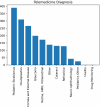Telemedicine at a University Ophthalmology Practice During the Beginning of the COVID-19 Pandemic
- PMID: 39193320
- PMCID: PMC11348924
- DOI: 10.2147/OPTH.S460454
Telemedicine at a University Ophthalmology Practice During the Beginning of the COVID-19 Pandemic
Abstract
Purpose: The aim of the research was to evaluate the use of teleophthalmology at a university practice during the COVID-19 pandemic, specifically examining precision, effectiveness, and patient satisfaction.
Patients and methods: Telemedicine visits were offered to new and established patients requesting appointments with the Stony Brook University Department of Ophthalmology between March 30 and June 2, 2020. Records from these visits were reviewed for chief complaint, past medical and ocular history, diagnoses, treatment/management, and providers' sub-specialty. Precision was determined by comparing agreement between diagnoses of the telemedicine visit with those of the subsequent in-person visit. The decision to follow up in person was made by the physician and patient. Diagnostic precision as well as progression, improvement, or stability of patients' symptoms were determined by the physician's assessment at follow-up visits. Post-telemedicine visit satisfaction surveys were sent to all patients.
Results: Telemedicine visits were offered to 783 patients, 520 (66.4%) of whom accepted. Of these 520 patients, 409 (78.7%) were established and 105 (20.2%) had in-person, follow-up visits. Overall, the diagnostic precision of the follow-up visits was 89.5%. Precision differed significantly across ophthalmologic subspecialties. Of the patients who had in-person follow-up visits, 56.8% remained stable, 32.4% improved, and 10.8% worsened. Established patients presented with more extensive ocular histories/procedures and experienced a higher percentage of worsening symptoms/disease stage compared to new patients. Oculoplastics/orbit was the most prevalent diagnostic subspecialty that worsened. Surveys were sent to all patients completing telemedicine visits, 15.0% of whom responded. Overall satisfaction was 91.9%, although only 23.0% of respondents preferred telemedicine to an in-office visit.
Conclusion: Telehealth provides high levels of precision and patient satisfaction for a wide range of ophthalmologic visits, although most patients still prefer in-office examinations. Employing teleophthalmology for follow-up and emergency care may provide patients with an effective alternative during pandemic situations and beyond.
Keywords: Teleophthalmology; coronavirus; teleglaucoma; telehealth; teleretina.
Plain language summary
Telemedicine involves integration of modern telecommunications technology into medical practice. Over the years, it has demonstrated greater and more widespread utility for different medical specialties, including ophthalmology. As a response to the recent COVID-19 pandemic, the Stony Brook University Department of Ophthalmology provided an option of telemedicine for patients in lieu of in-person eye examinations. In this paper, Stony Brook ophthalmologists report on their experience with teleophthalmology, particularly regarding its utilization, accuracy, effectiveness, precision, and acceptability. The authors examined the records of 520 patients who had telemedicine encounters between March 30 and June 2, 2020. Precision was determined by comparing the initial and final diagnoses of all patients who had an in-person follow-up appointment following a telemedicine visit. Of 105 patients that followed up, precision was determined to be 89.5%. Precision was compared across ophthalmologic subspecialties and found to be statistically similar (p>0.05). Approximately a third of patients improved, while nearly 11% worsened. Established and oculoplastics patients were more significantly likely to worsen. Surverys were sent out to study patients to gauge their satisfaction with their telemedicine experience. Although satisfaction was nearly 92%, only 23% of patients preferred telemedicine to an in-person physician encounter. The authors conclude that teleophthalmology provides a high level of diagnostic precision and patient satisfaction; nevertheless, most patients prefer in-person physician encounters. Telemedicine may provide an effective alternative to in-person ophthalmology assessments, especially during a pandemic. There appears to be a lesser but potentially useful role for teleophthalmology in a non-pandemic setting.
© 2024 Oganov et al.
Conflict of interest statement
The authors declare no competing interests or other conflicts of interest.
Figures


References
LinkOut - more resources
Full Text Sources
Research Materials
Miscellaneous

